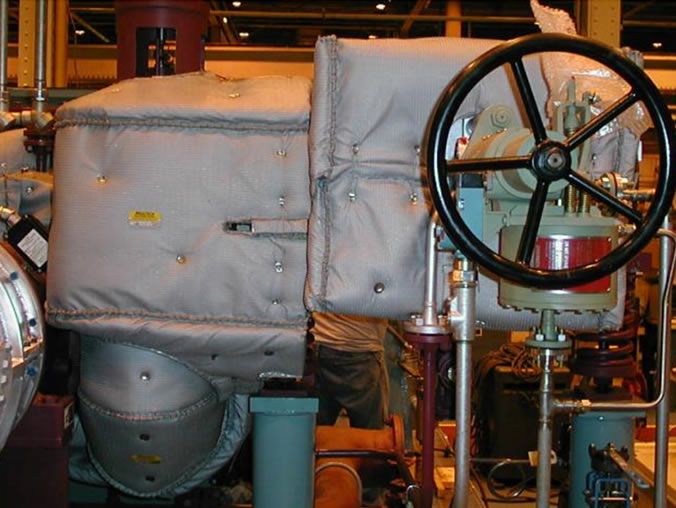ENGINE EXHAUST POWER GENERATION
HT1100A-MSGM (HT593C-A-MSGM)
INTRODUCTION
Shannon Acoustic Blankets are a CAD designed, CNC produced, high-quality pre-engineered insulation system designed to reduce noise levels, minimize insulation maintenance and improve the surrounding work environment. Shannon Acoustic Blankets are weather and chemical resistant. Shannon Acoustic Blankets are flexible, easy to install, remove and reinstall, allowing quick and easy access for serviceability. The key benefit is re-usability.
Shannon Acoustic Blanket Applications include: Engine Manifolds, Steam Turbines, Mufflers, Expansion Joints, Exhaust Piping, Fittings, By-Pass Piping and Turbo Charger Cases. Oil & Gas Industry, Private/Public Utility, Commercial.
This design is a Thermal/Acoustic Noise Reduction Barrier with a service temperature to 1100˚F (593˚C).
Acoustic Performance
4 – 15 DBA Reduction Overall
Finished Surface Mass
1.7lb/ft² (8.3 kg/m²) to 3.7lb/ft² (18.1 kg/m²)
Blanket Components
The Outer Jacketing consists of a layer of Stainless Steel Type 304 Knitted Wire Mesh .011” Dia. @ 16SF/LB (0.28 mm Dia. @ 3.3 m2/kg) and a layer of 17.0oz/yd² (577g/m²) Silicone Impregnated Fiberglass Cloth. A layer of “Mass Loaded Vinyl 1lb/sf to 2lb/sf Surface Mass (4.9-9.8 kg/m²) is placed under the Silicone Cloth to act as a “Reflector” of noise energy. The inner jacketing consists of a layer of Stainless Steel Knitted Wire Mesh (same as above) on the outside, encasing a layer of 18.0 oz/yd² (611g/m²) Plain Fiberglass Cloth. The Insulation Core Material is a 176.2 11 lb/ft³ (kg/m³) Fiberglass Needled MatType E Fiber and will act as an absorber of noise energy. The Fiberglass Mat is encapsulated by the Knitted SS Mesh, Silicone Cloth, Plain Fiberglass Cloth and SS Mesh, then stapled together, producing a Self Contained Blanket System. The Blanket System includes an Integral Fastener for install & removal. The combination of reflection and absorption will generate given expectations of noise reduction with varying surface mass and varying blanket thickness.

Steam Inlet T&T Valve to Steam Turbine
BLANKET THICKNESS SURFACE TEMPERATURE REFERENCE
Operating Temp |
Thickness |
Surface Temp |
Thickness |
Surface Temp |
Thickness |
Surface Temp |
|---|---|---|---|---|---|---|
| 371˚ C (700˚ F) | 40 mm (1.5″) | 69.2˚ C (156.5˚ F) | 50 mm (2″) | 59.8˚ C (139.6˚ F) | 65 mm (2.5″) | 53.6˚ C (128.4˚ F) |
| 427˚ C (800˚ F) | 40 mm (1.5″) | 79.2˚ C (174.6˚ F) | 50 mm (2″) | 68.1˚ C (154.5˚ F) | 65 mm (2.5″) | 60.7˚ C (141.2˚ F) |
| 482˚ C (900˚ F) | 40 mm (1.5″) | 90.3˚ C (194.5˚ F ) | 50 mm (2″) | 77.2˚ C (171.0˚ F ) | 65 mm (2.5″) | 68.6˚ C (155.4˚ F ) |
| 538˚ C (1000˚ F) | 50 mm (2″) | 87.4˚ C (189.4˚ F) | 65 mm (2.5″) | 77.3˚ C (171.2˚ F) | 80 mm (3″) | 70.1˚ C (158.1˚ F) |
| 593˚ C (1100˚ F) | 50 mm (2″) | 98.7˚ C (209.7˚ F) | 65 mm (2.5″) | 87.1˚ C (188.8˚ F) | 80 mm (3″) | 78.7˚ C (173.7˚ F) |
* The above referenced Cold Face Surface Temperatures should be used as guidelines for blanket insulation thickness design.
* The Cold Face Surface Temperature of the blanket should approach surrounding ambient temperature conditions.
* The economic thickness of the blanket should consider blanket cost, thermal performance and blanket design constraints.
* Heat loss calculations are based on a 21.1˚ C (70˚ F) ambient temperature using a flat surface condition.
THICKNESS |
SURFACE MASS |
Noise Reduction Range |
|---|---|---|
| 1” (2.5CM) | 1.8 lb/ft² to 2.8 lb/ ft² (8.8-13.7kg/m²) | 1.5 DBA to 6 DBA Reduction |
| 1 ½” (3.8CM) | 2.2 lb/ ft² to 3.2 lb/ ft² (10.7-15.6kg/m²) | 4 DBA to 8 DBA Reduction |
| 2” (5CM) | 2.6 lb/ ft² to 3.6 lb/ ft² (12.7-17.6kg/m²) | 5 DBA to 10 DBA Reduction |
| 2 ½” (6.4CM) | 3.0 lb/ ft² to 4.0 lb/ ft² (14.7-19.5kg/m²) | 7 DBA to 13 DBA Reduction |
* The above referenced Acoustic Performance should be used as a guideline for blanket insulation thickness design.
* The Acoustic Performance of the blanket should be bench marked against the ambient noise condition.
* The economic thickness of the blanket should be considered in selection of a target reduction with consideration to blanket design constraints.
* Contact Shannon for guidance in selection, as the historical performance of each application varies significantly.
